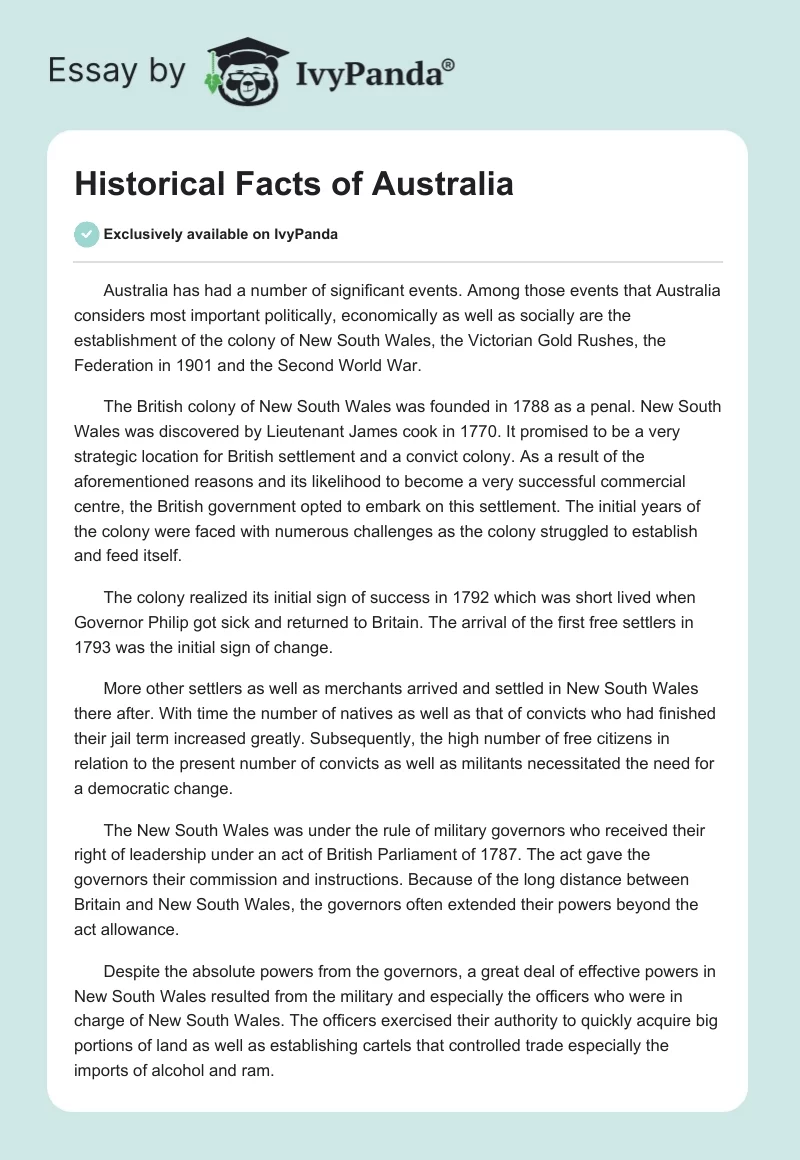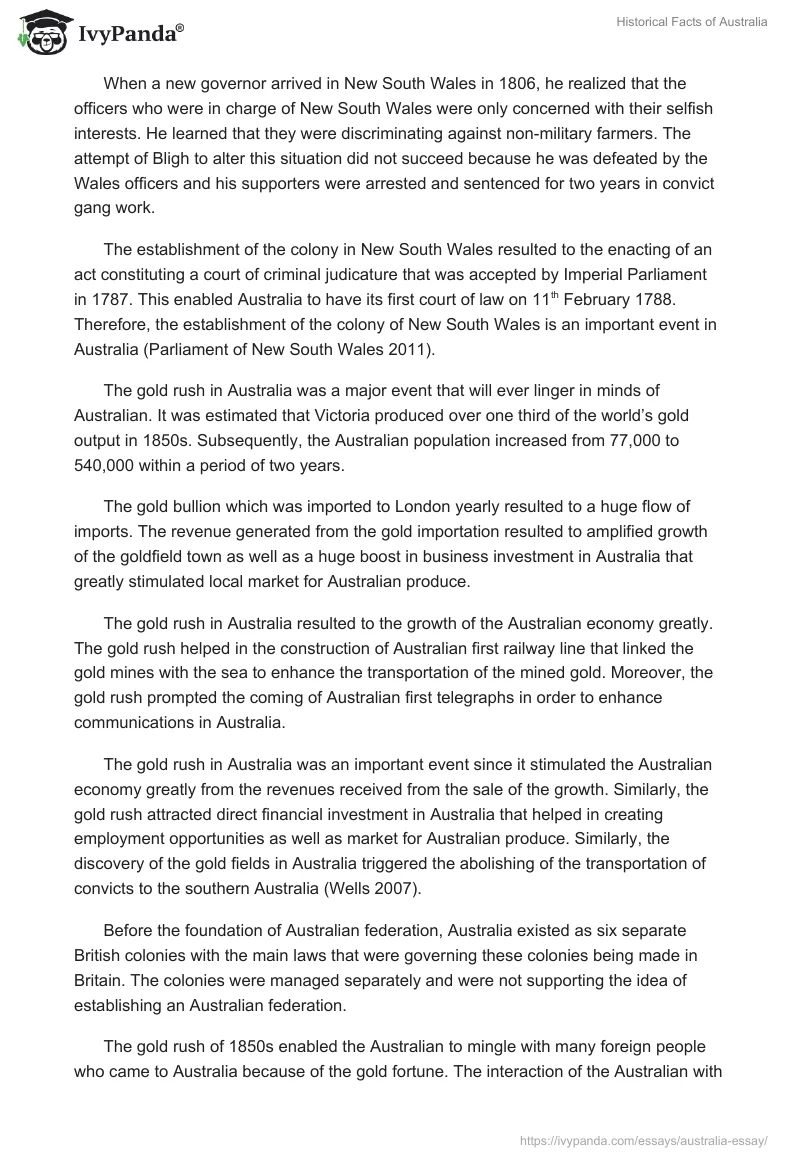Australia has had a number of significant events. Among those events that Australia considers most important politically, economically as well as socially are the establishment of the colony of New South Wales, the Victorian Gold Rushes, the Federation in 1901 and the Second World War.
The British colony of New South Wales was founded in 1788 as a penal. New South Wales was discovered by Lieutenant James cook in 1770. It promised to be a very strategic location for British settlement and a convict colony. As a result of the aforementioned reasons and its likelihood to become a very successful commercial centre, the British government opted to embark on this settlement. The initial years of the colony were faced with numerous challenges as the colony struggled to establish and feed itself.
The colony realized its initial sign of success in 1792 which was short lived when Governor Philip got sick and returned to Britain. The arrival of the first free settlers in 1793 was the initial sign of change.
More other settlers as well as merchants arrived and settled in New South Wales there after. With time the number of natives as well as that of convicts who had finished their jail term increased greatly. Subsequently, the high number of free citizens in relation to the present number of convicts as well as militants necessitated the need for a democratic change.
The New South Wales was under the rule of military governors who received their right of leadership under an act of British Parliament of 1787. The act gave the governors their commission and instructions. Because of the long distance between Britain and New South Wales, the governors often extended their powers beyond the act allowance.
Despite the absolute powers from the governors, a great deal of effective powers in New South Wales resulted from the military and especially the officers who were in charge of New South Wales. The officers exercised their authority to quickly acquire big portions of land as well as establishing cartels that controlled trade especially the imports of alcohol and ram.
When a new governor arrived in New South Wales in 1806, he realized that the officers who were in charge of New South Wales were only concerned with their selfish interests. He learned that they were discriminating against non-military farmers. The attempt of Bligh to alter this situation did not succeed because he was defeated by the Wales officers and his supporters were arrested and sentenced for two years in convict gang work.
The establishment of the colony in New South Wales resulted to the enacting of an act constituting a court of criminal judicature that was accepted by Imperial Parliament in 1787. This enabled Australia to have its first court of law on 11th February 1788. Therefore, the establishment of the colony of New South Wales is an important event in Australia (Parliament of New South Wales 2011).
The gold rush in Australia was a major event that will ever linger in minds of Australian. It was estimated that Victoria produced over one third of the world’s gold output in 1850s. Subsequently, the Australian population increased from 77,000 to 540,000 within a period of two years.
The gold bullion which was imported to London yearly resulted to a huge flow of imports. The revenue generated from the gold importation resulted to amplified growth of the goldfield town as well as a huge boost in business investment in Australia that greatly stimulated local market for Australian produce.
The gold rush in Australia resulted to the growth of the Australian economy greatly. The gold rush helped in the construction of Australian first railway line that linked the gold mines with the sea to enhance the transportation of the mined gold. Moreover, the gold rush prompted the coming of Australian first telegraphs in order to enhance communications in Australia.
The gold rush in Australia was an important event since it stimulated the Australian economy greatly from the revenues received from the sale of the growth. Similarly, the gold rush attracted direct financial investment in Australia that helped in creating employment opportunities as well as market for Australian produce. Similarly, the discovery of the gold fields in Australia triggered the abolishing of the transportation of convicts to the southern Australia (Wells 2007).
Before the foundation of Australian federation, Australia existed as six separate British colonies with the main laws that were governing these colonies being made in Britain. The colonies were managed separately and were not supporting the idea of establishing an Australian federation.
The gold rush of 1850s enabled the Australian to mingle with many foreign people who came to Australia because of the gold fortune. The interaction of the Australian with outside world helped them to appreciate the idea of the formation of a united federation. The coming of telegraph in Australia in 1872 augmented the communication among the Australian colonies and the idea of establishing an Australian federation started to be appreciated.
At first, the establishment of the federation faced a lot of challenges as some States especially the smaller States feared that the larger States will command more say than them. The issue was resolved and Australia was successful in establish an Australian federation. The federation helped in the creation of the nation of Australia and in the foundation of Australian constitution (Williamson 2000).
According to Robertson (1984), the Australian Prime Minister Robert Gordon Menzies announced the Australian participation in Second World War on 3 September 1939. This resulted to over one million Australian men and women being engaged in the Second World War. The Australian joining of Second World War resulted to more than 3, 500 Australian being killed in the war Campaign. More than 30,000 Australian being taken prisoners.
It is estimated that over 36 percent of those Australian who were taken as prisoners by Japanese troops died. Nevertheless, the Second World War brought some positive impacts to Australian (Peterson 1995).
The war led o the establishment of Women’s Auxiliary Australian Air Force, Women’s Royal Australian Naval Service as well as the Australian Women’s Army Service in 1941 and 1942. These units were established in order to discharge men from specific military responsibilities in base units in Australian for assignments with fighting units overseas (Australian War Memorial 2011).
It is clear that the establishment of the colony of New South Wales, the Victorian Gold Rushes, the Australian Federation in 1901 and the Second World War were all very important events in Australia. The establishment of the colony of New South Wales resulted to the foundation of Australian first courts.
The federation of 1901 enabled the Australian colonies to merge and form the Australian nation. The participation of Australia in the Second World War helped Australia to establish special women units in the military that help to discharge men some duties in order to make the Australian military more effective.
Lastly, the Victorian Gold Rushes which is the most important event in Australia helped to strengthen the economy of Australia. Moreover, it was also responsible for triggering the desire in the Australians to establish an Australian federation after interacting with foreigners who had migrated to Australia due to the gold fortune.
List of References
Australian War Memorial. 2011, Second World War. Web.
Parliament of New South Wales., 2011, A Convict Settlement in Sydney. Web.
Peterson, D., 1995, The Oxford companion to Australian military history, Melbourne: Oxford University Press.
Robertson, J., 1984, 1939–1945: Australia goes to war, Sydney: Doubleday Australia.
Wells, K., 2007, The Australian Gold Rush. Web.
Williamson, D., 2000. Federation in Australia, New York: Prentice Hall.


